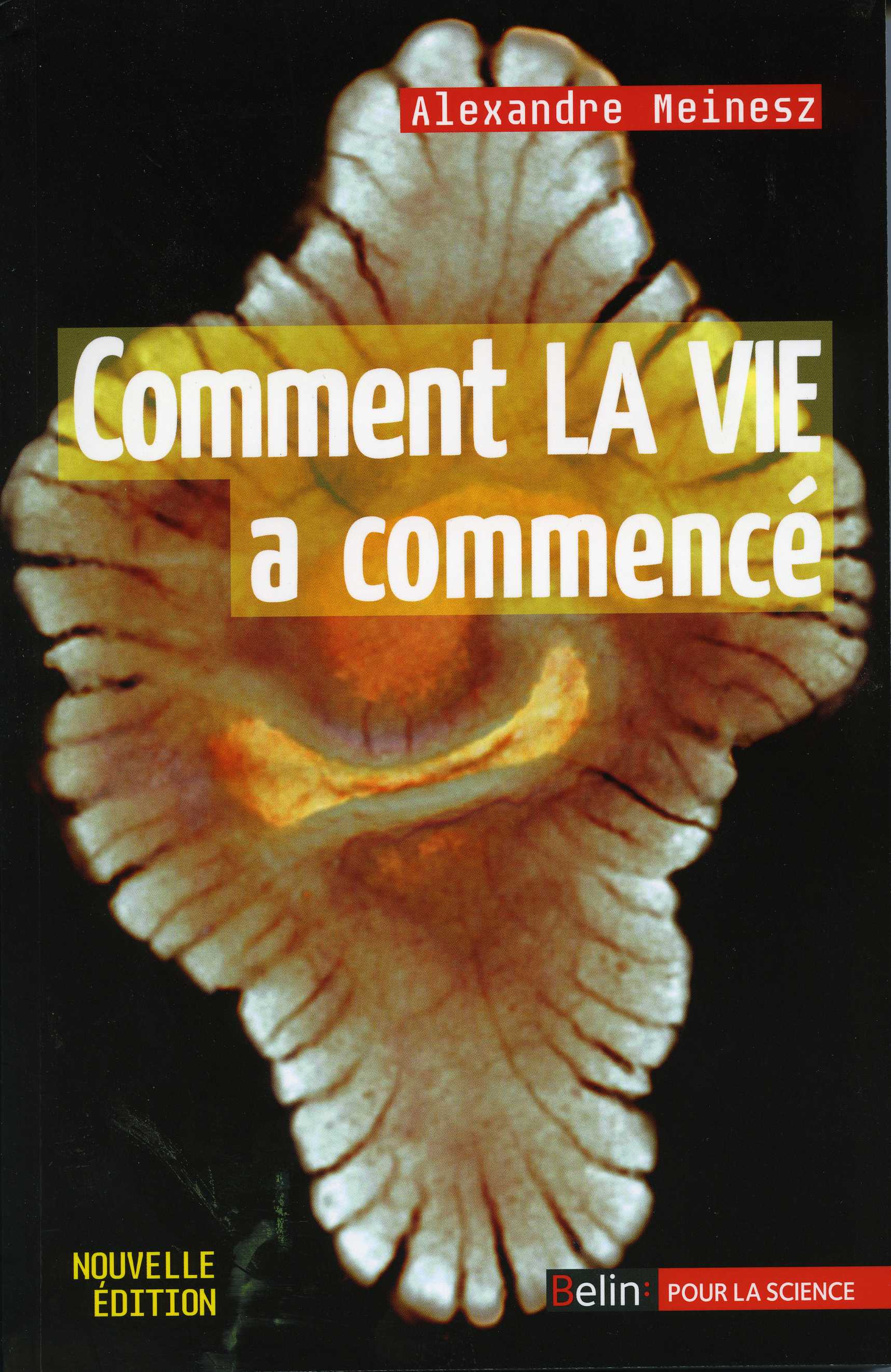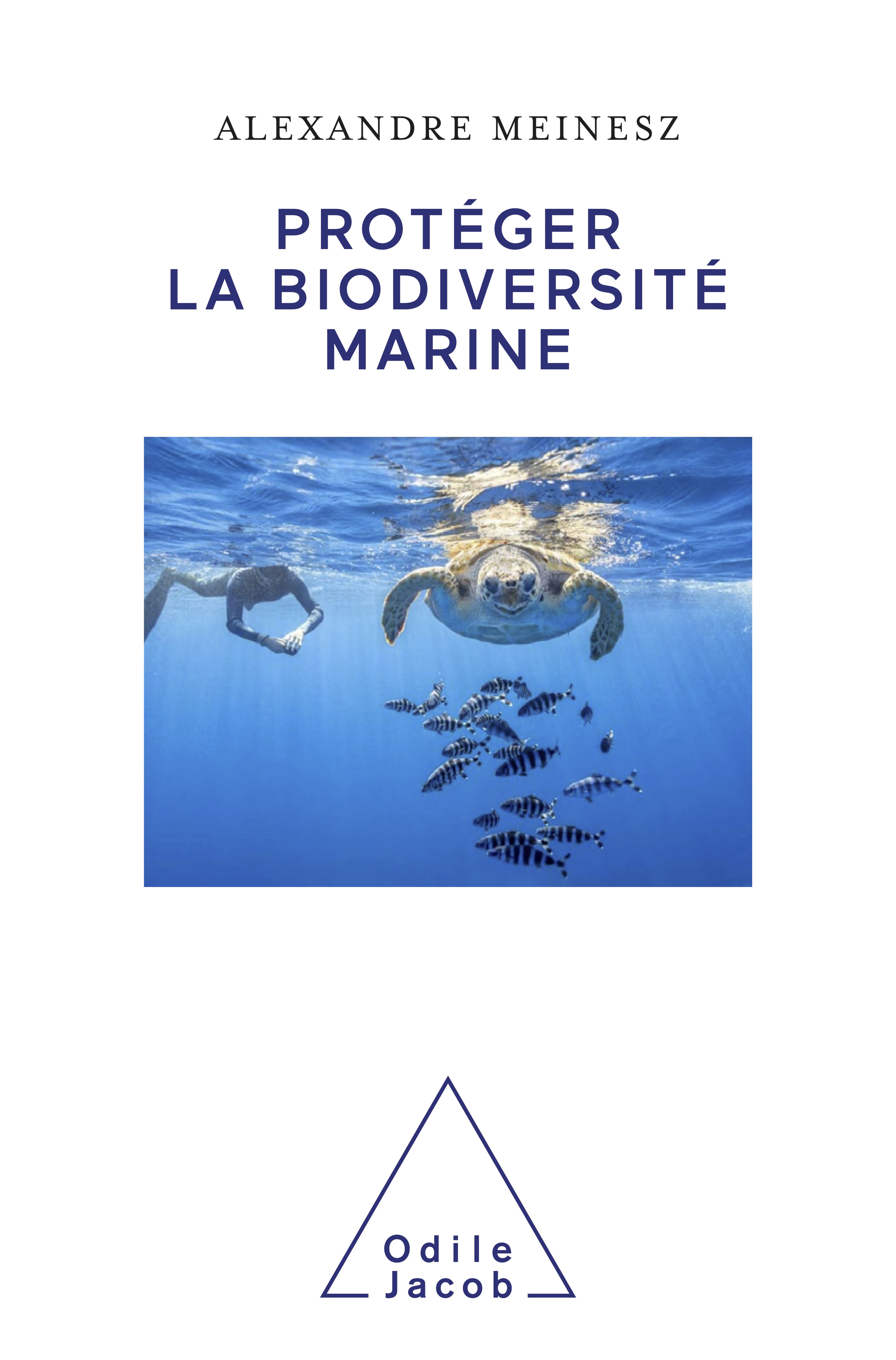

Synthèse de la 4e édition augmentée
Septembre 2014
Par Alexandre MEINESZ
Cette quatrième et nouvelle édition traduit lengouement des lecteurs pour ce livre très abordable sur les étapes de lorigine des différentes formes de vie. Publié initialement il y a trois ans aux Etats Unis en anglais (Chicago press university : « How life Began ») puis en France aux éditions Belin et en Turquie, cette nouvelle édition française a été complétée par les très récentes découvertes sur le sujet développé et comporte 80 pages supplémentaires.
Cet ouvrage met ainsi laccent sur les avancées de la science portant sur trois points essentiels concernant le commencement de la vie : Quand ? Où ? et Comment ?

Pour déterminer lépoque de lapparition de la vie sur Terre et répondre à la question « quand ? » de nombreux paléontologues sefforcent de trouver, identifier et dater les premières traces du vivant. Les publications sur ce sujet senchainent et la compétition internationale est grande pour trouver ces plus anciennes traces de vie. Aujourdhui nous pouvons affirmer que les traces datées de -3,4 / -3,5 milliards dannées sont attestées et incitent à penser que la vie est apparue sur Terre vers -3,9 / -3,8 milliards dannées, datation dautres traces plus ténues et encore quelque peu contestées. La saga de ces découvertes récentes est contée.
Pour ce qui concerne la question « où ? » il ny a que deux hypothèses possibles : la vie se serait formée sur Terre ou la vie est venue dailleurs.

A la lecture des dernières recherches pluridisciplinaires effectuées sur ce sujet et en recoupant ces informations, il faut admettre que la balance penche désormais très nettement vers la dernière hypothèse. Ainsi, tous les éléments étayant lhypothèse de bactéries contenues dans des météorites tombées sur Terre vers 3,9 milliards dannées sont présentées.
La lecture de la littérature scientifique de ces dernières années permet de constater que lon cherche peu à valider une origine terrestre de la vie. En fait les plus grands programmes scientifiques actuels concernent la recherche du vivant ailleurs. Les envois de fusées sur Mars, sur les planètes des satellites de Jupiter et de Saturne ou sur des météorites de grande taille, se multiplient.

La découverte dun grand nombre dexo-planètes (qui gravitent autour détoiles proches) et leur examen donnent de lespoir de trouver un environnement propice à la vie telle que nous la connaissons. Enfin nous assistons à un essor considérable de la recherche des constituants de météorites écrasés sur Terre et qui contiennent des molécules complexes constituant la vie.
Dautres recherches corroborent cette hypothèse comme celles établissant que certaines bactéries terrestres peuvent très bien survivre dans lespace. Des lots dorganismes terrestres amenés dans la station spatiale et placés à lextérieur plus dun an ont survécu ! Tous les chercheurs attendent dautres preuves pour que lhypothèse dune vie venant dailleurs soit définitivement validée.

Ce sera la plus merveilleuse des découvertes scientifiques des derniers siècles, découverte qui plongera lhumanité vers des mystères dignes des romans de fiction : quelle vie ailleurs et où ? Enfin pour répondre à la question « Comment ? », de nombreux laboratoires de chimistes des constituants du vivant se sont lancés dans un pari fou : construire la vie. Des avancées significatives sont notées mais nous sommes encore très loin davoir créé un être vivant capable de sauto-nourrir et de sauto-reproduire. Et si dans un avenir très lointain on réussira à franchir des étapes importantes dans ce registre, il conviendra de déconnecter ces découvertes des deux autres questions précédentes (Quand ? et Où ?). En effet, rien ne prouvera alors que la mécanique de montage du vivant décryptée est apparue à une certaine date sur Terre ou ailleurs.

On aura simplement mis à jour le procédé universel du montage chimique du vivant : un autre grand pas pour comprendre lorigine du vivant. Pour ce qui concerne les autres phases du développement de la vie sur Terre la recherche sest enrichie de nouvelles découvertes qui tendent toutes à reculer dans le temps lâge des principales innovations. Ainsi ces fossiles extraordinaires révélés il y a un an par une équipe du CNRS de lUniversité de Poitier.
Les paléontologues ont trouvé des formes énigmatiques de plus de 20 cm de longueur dans des roches au Gabon. Ce sont les plus anciens fossiles dorganismes vivants visibles à lil nu : ils datent de plus de 2 milliards dannées. Léditeur Belin a choisi leur image pour la couverture de cette quatrième édition.

Le fond de louvrage met laccent sur un nouveau principe à placer au dessus de lévolution : lUnion. Cest lunion de formes pré-bactériennes (des formes virales indépendantes ?) encore inconnues qui auraient donné les premières bactéries ; cest lunion de bactéries qui a donné 22 types différents dorganismes animaux et végétaux (ayant tous des cellules à noyau : « phymums deucaryotes» ), cest enfin lunion de cellules filles qui a donné les premières « civilisations » cellulaires constituant par la suite (par évolution) la faune et la flore visibles à lil nu.
Trois genèses de formes vivantes distinctes où A na pas donné B puis C par évolution mais A+B a donné C
Lorganisme C né dunion a ensuite évolué et ses descendants ont été sélectionnés par la nature comme Darwin la si bien décrit.

Lauteur étant spécialiste des algues, premiers organismes ayant peuplé les océans, a aussi mis en exergue le rôle fondamental des « algues bleues » qui sont en fait des bactéries contenant de la chlorophylle. Cest grâce à ces « cyanobactéries », de couleur bleu cyan, que loxygène est apparu dabord dans leau puis dans latmosphère. Ce déchet de leur fonctionnement (loxygène de la photosynthèse) a bouleversé les premiers équilibres naturels de la planète. Ce changement global, dû a un type dorganisme, a duré un milliard dannées et a conduit à la quasi élimination des microbes se développant dans un environnement sans oxygène. Ces cyanobactéries ont été la proie danimaux microscopiques ressemblant à nos globules blancs.

Certains ont survécu à lintérieur de leurs prédateurs. Ces cellules hybrides, nées dune union entre une cellule vorace (de nature animale) et une cellule passive (contenant de la chlorophylle) a donné naissance à toutes les cellules végétales classiques par évolution. Tous les végétaux chlorophylliens terrestres et ceux qui vivent sous leau possèdent au sein de leurs cellules des petites boites contenant de la chlorophylle, ces « plastes » ne sont que des cyanobactéries apprivoisées depuis plus de 2,8 milliards dannées. Elles contiennent encore de lADN typique aux cyanobactéries . Ces ex cyanobactéries apprivoisées se dupliquent en même temps que les cellules végétales pour qui elles sont indispensables. Enfin le troisième rôle primordial des « algues bleues », que lauteur a mis à jour dans sa synthèse, est celui de linitiation à la civilisation cellulaire.

Parmi les 22 groupes actuels de faune et de flore à cellules différentes contenant un noyau, seuls 5 sont visibles à lil nu. Leur architecture vient dun mécanisme identique : une union de cellules filles constituant une civilisation de cellules et, comme dans toutes les civilisations, les individus (les cellules) se sont différenciées. Contenant les mêmes informations, les cellules souches transformées en cellules spécialisées, répondant à des ordres internes, se différencient, se distinguent devenant par exemple des cellules de la peau, des neurones, des cellules sanguines... Comme il a été établi que des fossiles dalgues bleues datant de plus de 2,5 milliards dannées ont initié les premières civilisations de cellules (fossiles de formes filamenteuses pluricellulaires aux cellules différentes), lauteur a émis lhypothèse que le mécanisme architectural propre a ces « algues » a été transmis quà 5 des 22 groupes actuels de cellules à noyau.

Cest ainsi que comme les algues bleues, les animaux, les végétaux verts, les algues brunes et rouges et les champignons se voient à lil nu ! Ces 5 groupes ont en commun lorganisation initiée par des cyanobactéries. Ce livre est destiné au grand public. Il est largement illustré par des dessins originaux ou provenant des principaux auteurs scientifiques qui ont fait progresser les connaissances sur lorigine de la vie ces dernières décennies. Il permet de bien classer et hiérarchiser les futures nouvelles scientifiques sur le sujet de lorigine de la vie : elles sont toujours médiatisées mais trop souvent difficiles à positionner dans le contexte général et largement pluridisciplinaire de la recherche scientifique sur lorigine du vivant. Scientifiques, enseignants, philosophes ou religieux pourront trouver dans les abondantes notes et références, (près de 800), les sources originales de la littérature internationale actualisée la plus pertinente sur les sujets développés.





